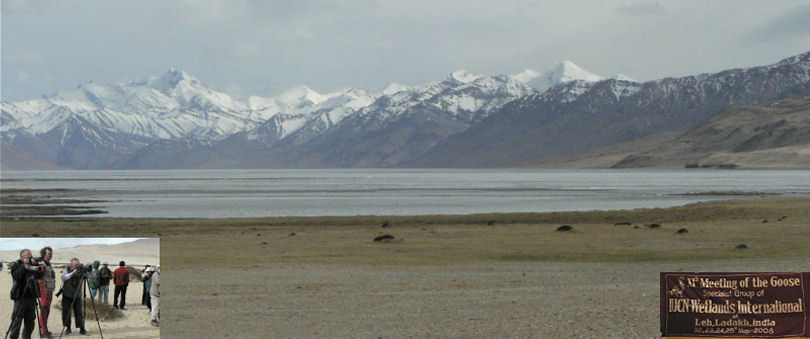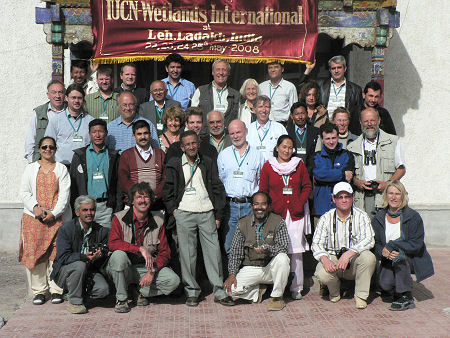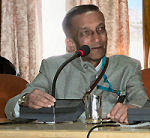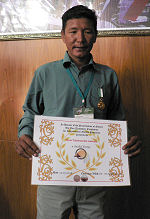Conference report
The latest and 11th Goose Specialist Group meeting was held from 22-25 May 2008 in Leh, Ladakh, India

The 11th meeting of the Goose Specialist Group took place in Leh, Ladakh, India from 22-25 May 2008. Despite the difficulties in organizing a meeting in such a remote place as the high mountains of Ladakh, in an area where the borders between India, China and Pakistan have not been settled, 34 delegates from 12 different countries managed to attend this meeting. Goose researchers from Belgium, Bulgaria, England, Estonia, France, Germany, India, the Netherlands, Russia, Sweden, Switzerland, and Ukraine gathered at an altitude of 3500 metres (11500 feet).
 |
|
Participants 11th meeting of the Goose Specialist Group
|
 |
|
Prakash Gole
|
I would like to congratulate Prakash Gole and his team from the Ecological Society from Pune, who already started preparations for this meeting two years ago with this great achievement. I am also very grateful for the support from the Ladakh Wildlife Department, who covered the costs for the conference hall and the final banquet, and who helped organize the magnificent post-conference excursion.
According to the usual formula for our meetings we gathered at a time of the year when geese are present near the meeting venue. This time the focus was on Bar-headed Geese (Anser indicus), of which Ladakh is the only nesting area within India for no less than 500 pairs. During the post-conference excursion to Tso Moriri (Lake Moriri) we found some hundred Bar-headed Geese which had just started to lay eggs on 26 May. By telescope from a distance we could see three nests with one egg, and one with three eggs on a very barren small island in this huge lake, Tso Moriri (see picture above)
Of course, I realize that it was not possible for all goose researchers to attend this special meeting, because many had to start their arctic field work already in the end of May. However, I feel the benefit for Indian researchers in particular to have a meeting in India justifies the decision to hold this meeting in the Transhimalayas.
This meeting was the second one in Asia of the Goose Specialist Group (the 4th was held in 1999 in Matsushima, Japan), and the third scientific meeting on geese ever held in Asia, because in September 1990 Aleksandr Andreev organized the very first Asian goose meeting in Magadan, Russia.
Usually the chairman and the convenor manage to find funding to assist delegates in their travelling expenses, but despite the many efforts made by Prakash Gole and me all our applications for funding were turned down. Luckily we could help covering the actual costs for staying in Leh and for the post-conference excursion for some delegates, and for all other delegates these costs could be kept extremely low thanks to the help from the Ecological Society and the Ladakh Wildlife Department.
Contents of the Ladakh-meeting
The meeting attracted several people – Herbert Prins, Blaise Humbert-Droz, Tsewang Namgyal, Pankaj Chandan (WWF) - who had many years of experience about nature conservation on the high plains of Ladakh and informed us about the problems that birds nesting in this area face, such as increased number of live-stock (goats and sheep), increased eco-tourism, increased number of stray and feral dogs, but also about solutions to reconcile nature conservation issues with the local economical interests.
In the final programme you will see many interesting issues that we touched upon. As many of the geese wintering in Europe also nest in or perform special moult migrations into Asia (Red-breasted Geese, Dark-bellied Brent, Greater White-fronted and Bean Geese), the importance of Asia for geese stretches well into Europe. Simon Delany presented an overview of the current knowledge on numbers of geese wintering in Asia.
Bar-headed Geese (Anser indicus) featured high with 5 oral presentations and 1 poster touching upon this species. Joost van der Ven presented an tentative overview of the knowledge of the both the winter and nesting distribution of Bar-headed Geese. Thomas Heinicke presented an overview of the current knowledge of the distribution in the past and present of different subspecies of Bean Geese that occur in Asia. Herbert Prins gave an excellent overview of the problems migratory birds face when they have to cross the Himalayas.
All these presentations will appear in print (either as full papers, or as abstracts ) in the well-known British journal Wildfowl, and a special guest editorial board led by Eckhart Kuyken (supported by Bart Ebbinge, Ralf Kurvers, Asad Rehmani, and Gerard Ouweneel) will assist Eileen Rees in reviewing the papers.
Report about the Meeting of IUCN-SSC chairs in Abu Dhabi
The Chairman also reported about the first ever meeting of chairs of the Specialist Groups of the IUCN, to which our specialist group belongs. This meeting was held at the initiative of Holly Dublin and in Al Ain, Abu Dhabi from 11-14 February 2008. For this meeting all Chairs were asked to produce a poster [link to pdf] about the key activities of each group. At this meeting several other specialist groups that also are part of Wetlands International were present (Seaducks (Stefan Pihl), Flamingos (Brooks Childress), Herons (Jim Kushlan), Loons (Joe Kerekes) and Fish), and they all expressed their great concern about the apparent lack of interest that Wetlands International has recently shown for its specialist groups. Holly Dublin, as chair and driving force behind the IUCN-SSC, has contacted Jane Madgwick, the present director of Wetlands International, and I hope that this will lead to improvements in the way Wetlands International will deal with its specialist group coordinators.
During this very stimulating meeting in Al Ain, I decided to agree to lead the Goose Specialist Group for another full term of four years.
The way forward of the Goose Specialist Group
As a follow-up on the discussion in Xanten on how to proceed with the Goose Specialist Group (see Xanten document), we have now formed a small strategic working group, consisting of Herbert Prins, Leif Nilsson, Nicholas Tubbs from Wetlands International, Jesper Madsen, Thomas Heinicke and Eckhart Kuyken, that will assist the chairman to work out a forward plan that will be presented during the 12th meeting of the Goose Specialist Group in October 2009 in Sweden.
Key items will be: improved management of the website, the revival of a Goose Bulletin (electronic version), more forward planning for the coming meetings so that the members will be informed beforehand about the coming two meetings (12th and 13th), strengthening the ties with the Russian Swans, Geese and Ducks Working Group, and fundraising to help less wealthy members covering the costs of attending the meetings.
Golden medal of the van Tienhoven Foundation for Sushil Dorje
 |
|
Sushil Dorje
|
On behalf of the Van Tienhoven Foundation for International Nature Protection, Prof. Herbert Prins awarded Sushil Dorje during the meeting of the Goose Specialist Group with the Golden Medal for his outstanding activities in reconciling the interests of nature conservation and local rural economies in this high altitude range where among others Bar-headed Geese come to nest. Local Indian TV and newspapers paid attention to this special occasion.
Born in a farmer’s family in the remote, high altitude Himalayan village of Kibber in Spiti Valley, Sushil Dorje started his conservation career as a field assistant in a research project in 1996. Armed with limited education in a village school, no formal training as a ranger, but a deep curiosity about nature, Sushil’s growth into one of the most committed conservationists in the region has been remarkable. Today, he is motivating the youth of Spiti to help protect wildlife, and has helped stop the occasional hunting that used to take place. He has also helped expand a community-based livestock insurance programme –started in his village to address human-snow leopard conflicts – to eight other villages in Spiti and Ladakh. He has been involved in the setting up of two village wildlife reserves and is working with several schools to promote conservation education and awareness amongst Spiti's children. Sushil is a fine naturalist and also provides support and advice to many researchers working in the region. Working selflessly at frigid heights of 4000 to 5500 m, he contributes much more for wildlife conservation than what can be expected from the small income he derives. He is also involved in monitoring the performance of conservation efforts by coordinating camera-trapping studies of the snow leopard, and monitoring mountain ungulates and birds.
Resolutions
Four resolutions were adopted by the meeting, one about reconciling increased human activities and nature conservation on the high altitude plains of Ladakh, one about the worrying goose hunting activities in Bulgaria, one about the decreased level of protection that geese wintering and nesting in the Netherlands are exposed to, and finally one about the worrying low population sizes of geese in East-Asia.
Next meeting
Leif Nilsson kindly accepted to host the 12th meeting of the Goose Specialist Group in southern Sweden, near Falsterbo from 9-14 October 2009. More information will be announced on this website this coming autumn, but note the dates in your agenda.
Report by Bart Ebbinge (Alterra, Wageningen (NL), Chairman of the Goose Specialist Group.